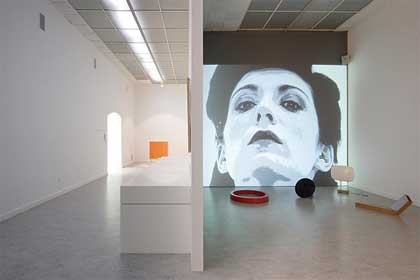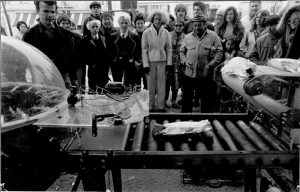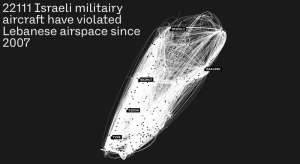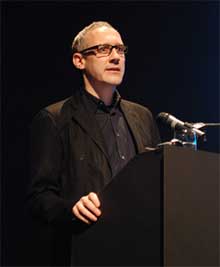 Now this is getting embarrassing. I’m posting something about Fiona Raby & Tony Dunne nearly every month, linking to their magical shrinking website or reporting from their students‘s shows. However, it would be odd to blog every single talk of the Innovationsforum Interaktionsdesign but not his. Especially as it was so good. I shooted a video of Dunne’s talk but the sound is really awful. So here’s some notes again.
Now this is getting embarrassing. I’m posting something about Fiona Raby & Tony Dunne nearly every month, linking to their magical shrinking website or reporting from their students‘s shows. However, it would be odd to blog every single talk of the Innovationsforum Interaktionsdesign but not his. Especially as it was so good. I shooted a video of Dunne’s talk but the sound is really awful. So here’s some notes again.
His talk focussed on Design for debate and in particular about the shift from thinking about design for application to exploring the implications of technology. It’s not about making technologies more useful and beautiful but about trying to understand the social, cultural or ethical effects of these technologies. The technologies are not limited to the electronic and digital ones. Biotechnology, nanotechnology have also to be taken into account. What will happen when they will start to move out of laboratories? We’ll probably face some rather complicated situations.
Potential of design to help facilitate a debate about the kind of future we want and the kind of products and technologies we want. How are new technologies going to affect the way we live?
To engage with this, i guess design will have to evolve in different ways: new roles, new uses for design and also new methods to deal with that.
It’s not about trying to predict the future and get into forecasting but simply about trying to move upstream and not waiting for science to become technology and then products and then design at that level. It’s about trying to think about new possibilities while we are still at a scientific stage and design in a way that might facilitate a public discussion about what we want.
Those concepts were illustrated by a mix of projects from his students and Design Interactions (RCA, London) and those he developed with his partner Fiona Raby in their practice.
The course is basically a course of interaction design but the technological scope is wider. They are also not only dealing with electronic and digital technologies but are also wondering how designers can engage with bio or nanotechnologies. When you start to connect with those fields the usual prototype phase is not always possible, unless you’re working with a scientist or an engineer. So those projects are more about ethics and what happens when you start dealing with different materials and growing products and stuff like that. But how do we deal with the future without floating into a fantasy space? How can we position ideas in the next 10, 15 to 20 years in a meaningful way?
First a handful projects from 1st years students:
In class, students do a project called Complicated Needs, the goal is to try to think of us not as users and consumers but go beyond that and acknowledge peoples’ complexities, contradictions, and irrationality. And the students are asked to find a phobia or an anxiety and not to design a solution to cure that anxiety but to design a placebo.
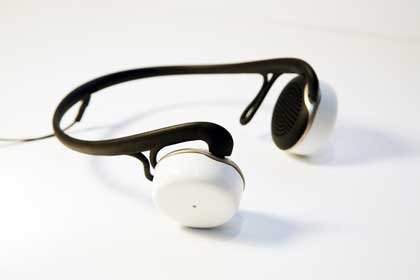
First example is Peer Pressure, by Alice Wang. It’s about the need to conform. Alice investigated whether products could be designed to help you create the perfect secondary personality to maximize your chance to fit in a new working environment.
The popular mobile beeps at regular intervals to pretend you’ve just received another SMS. The fast typing keyboard is a software designed to produce the sound of a multitude of letters typed at high speed even if you’re only touching one or two keys. The positive printer filters your email inbox and prints out invitation to exclusive parties, requests from the press or producers who fell in love with your new projects, etc. The double sided headphones are for people who like “embarrassing” music. It plays one track inwards and one track outwards simultaneously.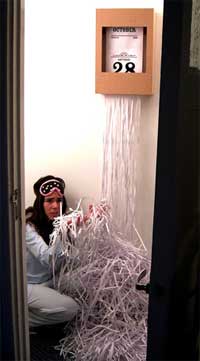
Susanna Hertrich’s Chrono_Shredder is part of a series called Me, Only Better that investigates biotechnology. This product belongs to a future society in which human hibernation is used commonly as a way to slow down the natural ageing process. If we sleep for a month for example, how would we feel when we wake up?
Suzanne has managed to ground in a product a topic which seems so difficult and abstract. The Chrono_Shredder features the 365 days of the year on a paper-roll which is led through a shredder. The shredding-device is programmed to use exactly 24 hours to shred one “day”. When you wake up the amount of time you have lost is clearly visualized.
Third project is dealing with nanotechnology. Nanotechnologies might give us trousers that don’t smell, new ranges of sun creams and cosmetics and other extremely banal applications. Then we read all the time about grey goo and self-assembling machines. The Design Interactions department wanted to find a space in between these extremes. Christopher Woebken got interested in organic material and processes and started to think of nanotechnology not in terms of services or products or chemical treatments but as medium. How would nanotechnology suggest new interactions with our environment? Christopher’s New Sensual Interfaces project wonders how we would interact with organic & grown electronics and how this would affect our lives and work. What would be the new possibilities for more pleasurable interface experiences? Prosposal of an answer in the video!

Such project is not about telling what the world will be like in 20 years time but it highlights the way nanotechnology will change our environment, what will happen to our computer screens when it’s there.
In second year, the students develop more substantial projects. The space is quite open and this year about one third of the students is working on concepts related to nano and biotechnologies and 2/3 work on digital technology.
Going back to The Meat of Tomorrow, a project that James King presented last year at the RCA show. The project is inspired by Tissue Culture & Art Project‘s Disembodied Cuisine which Dunne saw in Nantes, France in the exhibition L’Art Biotech a few years ago. The artists grew frog skeletal muscle over biopolymer into a steak. The frog was still alive and well and the inhabitants of Nantes were invited to taste it over a feast. Researchers are developing such “victimless meat”. In the future would we go to a restaurant and take part to some “eat yourselves parties”? What happens if we put this scientific research into a more messy, commercial space?
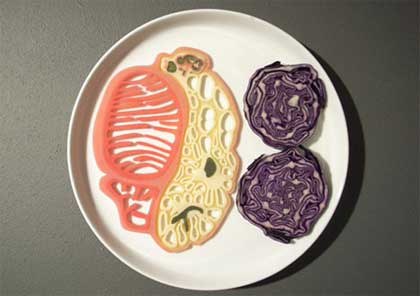
King imagined a near future where animals are not used for food anymore. Mobile animal MRI [Magnetic Resonance Imaging] unit scours the countryside looking for the most perfect examples of cows, pigs, chickens and other livestock. The creatures would be scanned to create accurate cross-sectional images of their inner organs. The most aesthetically pleasing examples of anatomy would be used as templates to create moulds for the in-vitro meat. Thus these totally artificial pieces meats would get a connection back to the animals and maybe become more acceptable.
James used plastic representations of these pieces of food as props to facilitate a discussion with ordinary people about what they felt about this potential future of food. So it’s not about coming up with a clever application of a technology or a really good commercial exploitation. Whereas the artistic project of Oron Catts was more disgusting, in the design project you see something more aesthetic.
A few projects by Dunne&Raby:
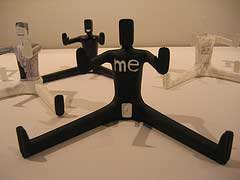 Evidence Dolls, commissioned by the Centre Pompidou in Paris, were created to provoke discussion amongst a group of single women about the impact of genetic technology on their lifestyle. The dolls are used to store genetic materials as a form of insurance policy in the dating game. Women would collect nail clippings, dental floss, etc and keep them in the penis-drawer. At no point did the designers think that it was a great idea to commercialize but used it to facilitate a discussion with a group of women in their 20s and early 30s about genetic identitites and how it could affect their ideas of love, etc. Science is developed outside of the public realm that’s why it is important to get a debate about important issue that will shape our future life. Before it is too late. The designers had many plastic dolls manufactured to give the feeling that they were tangible, real objects. They used them to ground a conversation on a rather abstract subject. Women received blank dolls that they could customize to make them reflect the way their lover looked or was like.
Evidence Dolls, commissioned by the Centre Pompidou in Paris, were created to provoke discussion amongst a group of single women about the impact of genetic technology on their lifestyle. The dolls are used to store genetic materials as a form of insurance policy in the dating game. Women would collect nail clippings, dental floss, etc and keep them in the penis-drawer. At no point did the designers think that it was a great idea to commercialize but used it to facilitate a discussion with a group of women in their 20s and early 30s about genetic identitites and how it could affect their ideas of love, etc. Science is developed outside of the public realm that’s why it is important to get a debate about important issue that will shape our future life. Before it is too late. The designers had many plastic dolls manufactured to give the feeling that they were tangible, real objects. They used them to ground a conversation on a rather abstract subject. Women received blank dolls that they could customize to make them reflect the way their lover looked or was like.
The last project was developed for Designing Design Interaction exhibition at Z33 in Belgium. D&R got very interested in robots. The idea was that there are different kinds of robots today: the companions for the home, the monofunctional robots used in industries and the invisible robots that surround us, in the car for example. So the designers figured out that there might be space for a new “breed” of robots that have become part of the domestic landscape. It’s the next step, and it’s reached when having robots is no big deal anymore.
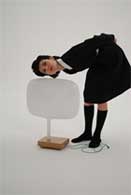

Tony talked about these robots in the interview i made of him a few weeks ago and now these notes of his talk are just getting too long, i wanna go to bed and i bet no one is reading me anymore so i’ll just link to the interview and add a few images (by Per Tingleff) to make the post pretty.
